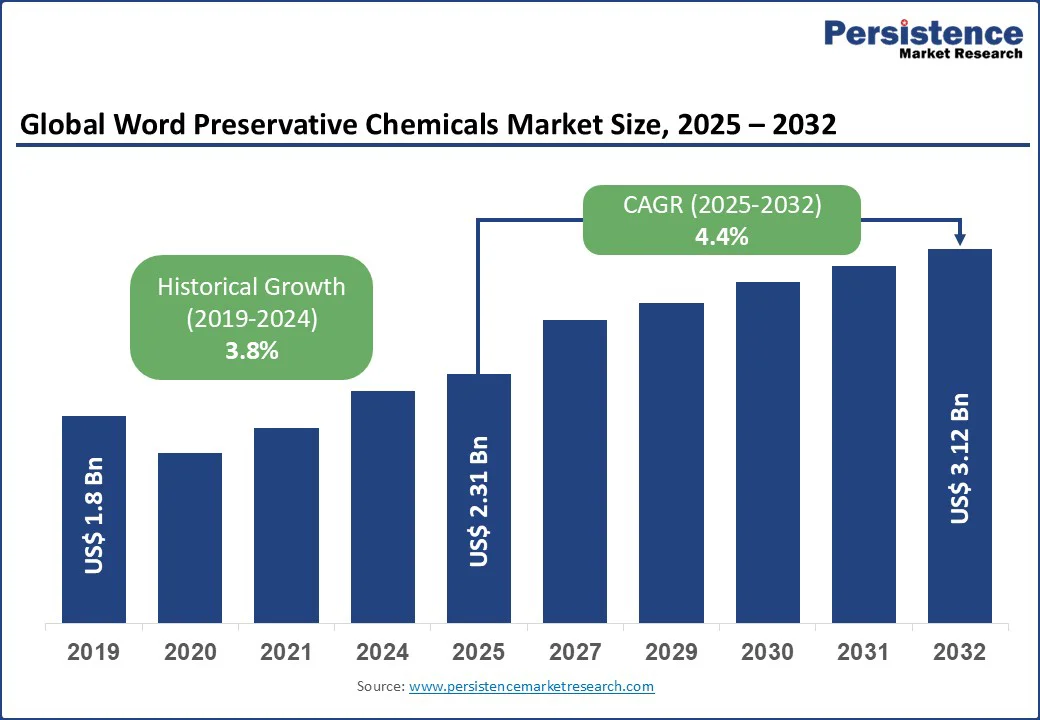ID: PMRREP3259| 188 Pages | 25 Sep 2025 | Format: PDF, Excel, PPT* | Chemicals and Materials

The global wood preservative chemicals market size is likely to be value at US$2.31 Bn in 2025 and reach US$3.12 Bn by 2032, growing at a CAGR of 4.4% during the forecast period from 2025 to 2032.
The wood preservative chemicals market is experiencing steady growth, driven by increasing demand from the construction, furniture, and industrial sectors, where wood preservation is critical for enhancing durability and resistance to environmental factors such as decay, insects, and weathering.
Key Industry Highlights

| Key Insights | Details |
|---|---|
| Wood Preservative Chemicals Market Size (2025E) | US$ 2.31Bn |
| Market Value Forecast (2032F) | US$ 3.12Bn |
| Projected Growth (CAGR 2025 to 2032) | 4.4% |
| Historical Market Growth (CAGR 2019 to 2024) | 3.8% |
The global wood preservative chemicals market is experiencing significant growth due to the rise in construction and infrastructure activities worldwide. Wood preservatives are critical for protecting wooden structures such as bridges, decks, and buildings from decay, insects, and weathering, ensuring longevity and safety.
According to the World Bank, global infrastructure investment needs are projected to reach $94 trillion by 2040, with significant allocations to emerging economies. In the Asia Pacific, initiatives such as China’s Belt and Road Initiative and India’s Smart Cities Mission drive demand for treated wood in construction applications.
In the U.S., the American Society of Civil Engineers estimates that 42% of public infrastructure, including wooden bridges, requires repair or replacement, increasing the need for preservatives. Companies such as LANXESS and Koppers Performance Chemicals reported a sales surge in construction-grade preservatives in 2024.
Government-led sustainable construction initiatives and rising urbanization ensure sustained demand, positioning construction as a key driver for market growth through 2032.
The wood preservative chemicals market faces challenges due to stringent environmental regulations and health concerns associated with certain chemical formulations. Traditional preservatives, such as creosote and chromated copper arsenate (CCA), face scrutiny due to their toxicity and environmental impact.
Regulatory bodies such as the U.S. Environmental Protection Agency (EPA) and the European Union’s REACH framework impose strict guidelines on chemical usage, limiting the adoption of solvent-based and oil-based preservatives.
In 2023, the EU banned certain high-VOC (volatile organic compound) preservatives, increasing compliance costs for manufacturers. Additionally, consumer preference for eco-friendly alternatives and concerns over worker safety during application further restrain market growth. Competition from non-chemical wood preservation methods, such as heat treatment, also poses a challenge, particularly in cost-sensitive markets, limiting the adoption of traditional chemical preservatives.
The increasing focus on sustainability and green building practices presents significant opportunities for the wood preservative chemicals market. Eco-friendly water-based preservatives, such as those based on copper azole and micronized copper, are gaining traction due to their low environmental impact and compliance with regulations.
The International Energy Agency projects that green building certifications, such as LEED, will drive demand for sustainable materials, including treated wood, by 2030.
Companies such as Viance and BERKEM are innovating with non-toxic, biodegradable preservatives for construction and furniture applications, aligning with global sustainability trends.
Government incentives, such as the EU’s Green Deal and the U.S. Inflation Reduction Act, encourage investments in eco-friendly technologies, creating opportunities for manufacturers to develop advanced, sustainable preservatives to meet evolving industry and consumer demands through 2032.

North America dominates the wood preservative chemicals market in 2025, capturing an estimated 36.8% of the global market share. This dominance stems primarily from robust demand across the construction and industrial sectors in both the United States and Canada.
The U.S. construction industry alone is valued at approximately $2.14 trillion in 2025, according to the U.S. Census Bureau, underpinning a substantial need for wood preservatives in residential buildings, commercial infrastructure, and public works. Wood preservatives play a crucial role in extending the lifespan of wooden structures, protecting them from decay, insect damage, and weathering.
Furthermore, North America benefits from advanced manufacturing infrastructure and well-established supply chains, enabling major players such as Viance and Koppers Performance Chemicals to maintain extensive distribution networks.
These companies are capitalizing on growing consumer and regulatory preferences for sustainable and eco-friendly preservative solutions. This shift toward greener products strengthens the wood preservative chemicals market position of North America, aligning with global trends favoring environmental responsibility while meeting the rigorous demands of modern construction and industrial applications.
Asia Pacific is the fastest-growing market for wood preservative chemicals, propelled by a combination of rapid urbanization, significant infrastructure investments, and abundant timber production, especially in China and India.
China, recognized as one of the world's largest timber producers, plays a pivotal role in ensuring a steady supply of raw materials for treated wood products. According to the Food and Agriculture Organization (FAO), China’s vast forestry resources support the growing demand for wood preservatives, particularly in construction and industrial applications.
India’s ambitious Smart Cities Mission further fuels market growth by emphasizing sustainable urban development and eco-friendly construction practices. This initiative drives increased adoption of green wood preservative solutions, aligning with the country’s commitment to environmentally responsible infrastructure development.
These factors collectively ensure the Asia Pacific’s rapid and sustained market growth through 2032, making it a key focus area for industry players seeking to capitalize on emerging opportunities and the region’s growing commitment to sustainability.
Europe stands is the second fastest-growing region in the wood preservative chemicals market, propelled by a combination of stringent environmental regulations, expanding construction activities, and robust growth in the furniture sector.
According to the European Construction Industry Federation, the region’s construction industry was valued at approximately €1,683 billion in 2023, reflecting significant investment in both residential and commercial projects. This expansive construction activity drives a growing demand for eco-friendly wood preservatives, as developers and regulators alike prioritize sustainability and compliance with strict environmental standards.
Germany’s furniture industry, a major consumer of water-based preservatives, is particularly influential, with leading chemical manufacturers such as BASF SE and LANXESS providing advanced, sustainable preservative solutions.
Europe’s focus on high-quality standards and sustainability fosters innovation in wood preservative formulations, encouraging the adoption of water-based and bio-based chemicals. This regulatory environment and market demand ensure continued growth, positioning Europe as a critical player in advancing sustainable construction and protecting wooden infrastructure through 2032 and beyond.

The global wood preservative chemicals market is highly competitive, characterized by a fragmented landscape with numerous domestic and international players. Leading companies such as Jubilant, LANXESS, Viance, and Koppers Performance Chemicals dominate through extensive product portfolios and global distribution networks.
Regional players such as Dolphin Bay focus on localized offerings in Asia Pacific. Companies are investing in eco-friendly formulations and advanced manufacturing technologies to enhance market share, driven by demand for sustainable preservatives in construction and industrial applications.
The Wood Preservative Chemicals market is projected to reach US$2.31 Bn in 2025.
Surge in construction and infrastructure activities, and growing demand for eco-friendly preservatives are the key market drivers.
The Wood Preservative Chemicals market is poised to witness a CAGR of 4.4% from 2025 to 2032.
The rising demand for eco-friendly and sustainable preservatives is the key market opportunity.
Jubilant, LANXESS, Viance, and Koppers Performance Chemicals are key market players.
| Report Attribute | Details |
|---|---|
| Historical Data/Actuals | 2019 - 2024 |
| Forecast Period | 2025 - 2032 |
| Market Analysis | Value: US$ Bn/Mn, Volume: As Applicable |
| Geographical Coverage |
|
| Segmental Coverage |
|
| Competitive Analysis |
|
| Report Highlights |
|
By Formulation
By End-use
By Region
Delivery Timelines
For more information on this report and its delivery timelines please get in touch with our sales team.
About Author